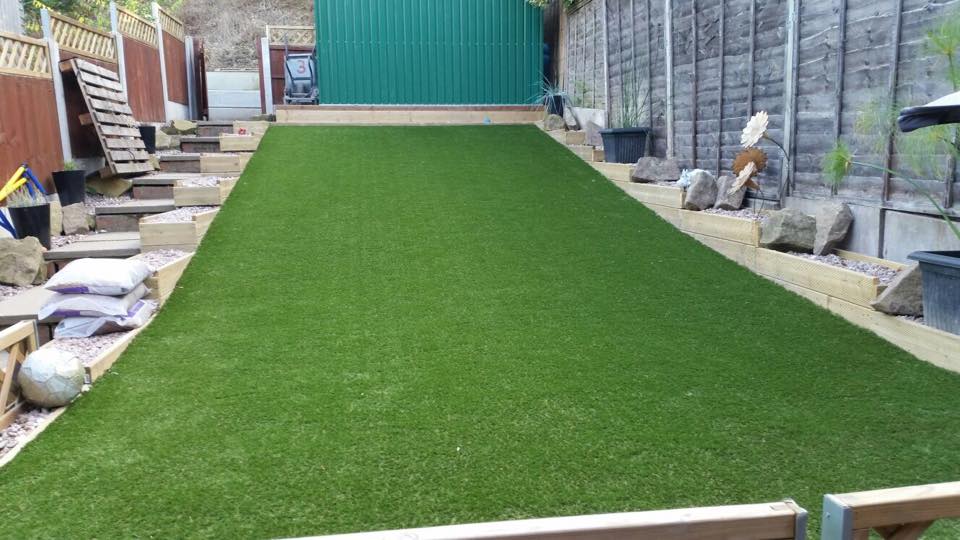How To Install Artificial Grass On A Slope?
A commonly asked question when it comes to artificial grass is: can it be installed on a slope? That answer is: yes! In fact, artificial grass is a great choice for sloped gardens for a number of reasons.
Firstly, natural grass in a sloped area can be a pain to maintain. Mowing it is difficult and cumbersome, particularly for individuals with mobility problems. Secondly, issues with drainage and shade can cause traditional lawns to develop patches, become bald, or even die in certain areas.
With artificial grass, this isn’t a problem. Maintenance is very low, and you never have to worry about your lawn not getting enough sun or water throughout the year!
If you’re considering artificial grass in your sloped garden, check out our handy guide below to help you on your way.
Step 1: Prepare your garden
The start of the process is pretty simple. You first need to clear the area of any grass, slabs or debris. You ideally want to get the surface to a point where any turf and topsoil is totally removed, along with anything else that may cause lumps or bumps under your artificial grass. We recommend around 3-4 inches of excavation. You’ll know when you have reached the natural sub base as the ground will feel firm underfoot.
Step 2: Lay timber planks
This is an essential step, because hanging timbers will prevent your new artificial grass from sliding down. Your timber planks should be set firmly in concrete along the top of the slope, ready for the artificial grass to be nailed to.
As in any normal installation, it is advisable to lay timber edging around the rest of the perimeter of your garden, too. Again, use concrete liberally to set them as this will ensure the planks do not migrate over time and warp the lawn.
Step 3: Add your sub-base
This step will ensure your grass stays flat. To begin your sub-base start with a layer of MOT Type 1 aggregate. This should be about 2-3 inches deep across the slope. Take your time with making this layer as even as possible! It may seem like hard work (because it is!) but getting it right here will do wonders for the finished product.
Once this is done, add 1 inch of granite dust or sharp sand across the top. Granite dust is particularly effective as it promotes drainage but makes a very smooth surface. Again, don’t rush this step, and take steps to make it compact and level.
Step 4: Apply a weed resistant membrane
For a weed-free garden, lay the weed resistant membrane on to the slope using galvanised nails to hold it in place.
Step 5: Lay your artificial grass
Now for the fun bit!
Lay your artificial grass at the top of the slope first. It is important at this point to make sure the pile is facing the right way (i.e. towards your home or wherever the artificial grass is likely to be viewed from).
At this point, you may want to leave it for a couple of hours to let it settle. This is because artificial grass is stored in rolls and is quite tightly packed. Rolling it out and letting it settle will help it move back to its natural shape ready for fixing into place.
When you have done this, it’s time to nail your artificial grass to the hanging timbers starting at the top. Each time you affix the grass, ensure it is smoothed out and there aren’t any lumps or bumps underneath.
Step 6: Join each piece of grass together
This bit is probably the trickiest, but it’s easy once you get into a rhythm! To join two pieces together seamlessly, firstly ensure each edge is straight. Then, put joining tape on both pieces of grass and line them up making sure they are touching but not overlapping.
When you have done this, put a line of glue along the back of each piece of grass, at the point where they meet. Our top tip for ensuring joins stay perfectly in place while the glue dries is to place nails along them. This is even more important on a slope, as gravity can cause them to slip and spoil a seamless finish.
Step 7: Top dress with sand & brush
Add kiln sand (or any other dry sand) liberally across the bank to weigh the grass down and push it into the slope. Then, brush the pile with a stiff, natural bristle brush to make the grass stand up.
And you’re done! That is everything you need to know about how to install artificial grass on a slope. For further information and guides for laying artificial grass, check out our article for installing artificial grass in gardens here.
Get Your Free Quotes Today
Whether you want to do-it-yourself or have someone do it for you, we can help you get the very best price for both supply and installation of artificial grass. To get started, click here and answer just a few questions. In a few minutes, we’ll connect you with the very best approved suppliers and installers in your area. What’s more, it’s totally free and could save you over £500!
